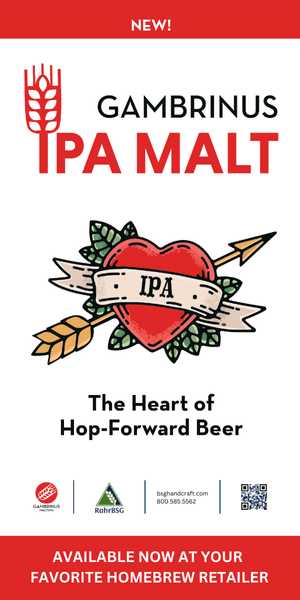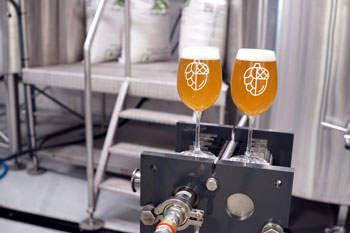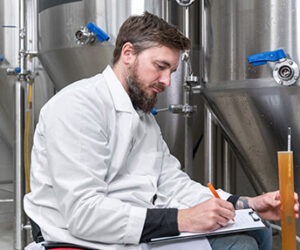Recipe Design Ethos

There are different considerations when designing a recipe for a craft brewery compared to a home brewery. I’m not talking about adjusting for mash efficiency or hop utilization, two things every brewer should do regardless of scale. This article describes techniques that craft brewers use to make brewing easier, and their results consistent year-to-year! Only some of these techniques have potential value for homebrewers, while others only have value when planning to scale a recipe for commercial production. Over the years I’ve collected advice while consulting, collaborating, and drinking with a wide variety of brewers, the lessons included here reflect what I’ve put into practice now that I’m brewing professionally.
Rounding to Package Size
Most homebrewers write grain bills with nice round percentages – 85% pale malt, 10% Munich, and 5% crystal 20. Commercial brewers are lazy (in a good way), so it makes sense to use an entire 50- or 55-lb. (22- or 25-kg) sack of malt even if the resulting recipe features 9.4% or 11.3% Munich malt. A deviation of a couple percentage points is unlikely to create a noticeable flavor difference in the finished beer. The exception is dark grains, which due to their intensity need more precision. In those cases ideally a half-sack can be used. If the beer comes in lower than the target gravity on the first iteration, the next will get an extra bag of base malt (rather than a little more of all the malts).
Similarly, many craft brewers try to avoid saving open packages of aroma hops for extended periods. Ideally, an 11-, 22-, or 44-lb. (5-, 10-, 20-kg) box is added as a single addition, or across multiple additions on a given brew day. This is good advice for homebrewers as well — unless you have a vacuum sealer. This approach also avoids a large number of leftover hop bags cluttering the freezer . . . a lesson I could stand to learn. If you do have older hops, then using them in the boil (rather than dry hopping) is preferred.
As a homebrewer brewing 11-gallon (42-L) batches, I often use one-third or half a sack of base malt, and specialty malts in pound increments (or half pound if needed). For hops I’ll buy by the pound, using up last year’s leftovers for hot-side additions while the freshest hops are reserved for dry hopping.
Blends of Hops
My preference is to use a simple ratio of two hops for aroma (1:1 or 2:1). This simplistic approach represents the sweet spot for me in terms of adding nuance to the hop character without creating a muddled-generic “green” hoppiness. This approach works for many craft brewers as well, in addition single-hopped beers have even gained traction as one-off or rotating releases. However, if a craft brewer is designing a year-round flagship IPA, best practice is to include three or more aroma varieties. This allows the brewery to swap out one variety for another if scarcity, agronomics, or demand causes supply issues. Although hop contracts help minimize shortfalls, swapping varieties can address uncontrollable issues that endanger the viability of a recipe, especially helpful for relatively newhop varieties.
When a substitution is required, it is easier to get away with replacing a quarter of the hops in a beer than it is to replace half or all. While using a hop-oil calculator (my Sapwood Cellars’ partner Scott Janish has a nice one here: http://scottjanish.com/hop-oils-calculator/) to mimic the oils of the replaced variety is a great start, confirming pilot batches are required as small oil fractions can alter the perceived aroma of the beer. It may be that for a given hop, one variety is better as a hot-side substitute and another for dry hopping as both timing and temperature determine which aromatics survive into the finished beer. See my article “Hop Oil Analysis and Blending”, BYO December 2015.
Even if all hop varieties remain available from the same farms, aroma could change thanks to annual weather differences or harvest timing. This variability can again be dampened by a larger blend of hops. For craft brewers this variability is further mitigated by traveling to Yakima, Hallertau, or Nelson for hop selection. The goal is not necessarily to pick the “best” lots, but rather the ones that provide continuity of flavor.
As a homebrewer, I’d rather brew the best batch I can today . . . and not worry about making that identical beer again. I’ll buy Citra®, Galaxy, and Nelson Sauvin when I can find them, and create something unique with other varieties when I can’t. This approach has become more common for NEIPA-focused breweries that do heavy can-sales on premises; they simply won’t brew a particular IPA if the relevant hops are not available.
Consistent Ingredients
One of my favorite aspects of homebrewing beer compared to other fermentations I’ve tried (e.g., sourdough bread, kombucha, and ginger beer) is that I only have to brew when I’m in the mood. I don’t have to “feed” brewer’s yeast on a weekly basis. Craft brewers don’t always have this luxury. A commercial pitch of liquid yeast costs hundreds of dollars, a not-insignificant percentage of the total price-tag. On a commercial scale, quick-repitching is also essential because large volumes of yeast slurry generate heat, leading to quicker reduction in cell viability. As a result, most craft breweries have one or at most two house yeast strains that they use to ferment their core beers. Thanks to their low price-point and high shelf-stability, dried yeast is an appealing option for breweries without a schedule that allows harvesting.
Homebrewers derive important benefits from learning about a strain from repeated brews, but starting out I’d value variety to discover a few favorites for focus. Still, there can be pleasant surprises with minimalism. JC Tetreault from Trillium Brewing (Boston/Canton, Massachusetts) mentioned that at first he used an English yeast in his IPAs because he had selected it for the porter. The results were delicious, unexpectedly hazy, and people loved the subtle addition of yeast character to the hoppiness, so he rolled with it. A limited color palette sometimes produces the most beautiful and unique paintings!
When a craft brewer orders a special yeast strain, they’ll often string a few batches together with increasing gravity and bitterness. For example: Hefeweizen, to hoppy wheat, to weizenbock. This pattern works well for homebrewers as well, and supports more brewing with less time making starters. Another option that we are experimenting with at Sapwood Cellars is blending dried yeast strains for added variety, and at a price-point that doesn’t require repitching (see Ziparillo recipe below).
The parallel for grain is that, as breweries grow, they often add a silo of their base malt of choice. This is usually a compromise that suits all of the beers well enough. Our first few test batches for Modern Times (San Diego, California) Black House coffee stout used Maris Otter as the base. I was surprised how much depth and richness the beer lost when we switched to North American standard 2-row malt to suit the hoppy beers. Luckily once the production brewers took over they restored that lost depth by adding biscuit andpale chocolate.
Many breweries use a single hop for bittering all of their beers. This allows for a consistent and predictable amount of IBUs. CO2 hop extract has become popular as well, see “Hop Extracts” in the July/August 2018 issue of BYO. As a brewery expands it may grow big enough to get an entire hop lot pelletized . . . but not big enough to get several. You may notice growing breweries have a year or two where they seem to use one hop variety in most of their beers for this reason. More breweries are also using a limited selection of less expensive high-oil hops for whirlpool additions (Columbus, Chinook, Nugget, Bravo etc.), dry hopping with more expensive varieties to add the unique character.
Care about Source
When I talk to other professional brewers about ingredients, they usually specify which maltster, yeast lab, or hop provider they prefer or are referring to. Despite the names, Briess roasted barley (~300 °L) isn’t a substitute or even a similar product to Muntons roasted barley (~500 °L). Their flavor and color contributions are completely different, so you need to be aware of which you are using. You’d be better off with Briess black barley or even black malt if you needed to substitute for Muntons because the color and flavor contributions are more similar than the names suggest. Similar story for various °L-designated caramel/crystal malts, and base malts. At the very least, start asking your homebrew supplier who the maltster is when you buy from the bulk bins if it isn’t listed. Note the specific products in your recipe so you can recreate it.
There are concordance charts showing which commercially available yeast strains are from the same source. By the very nature of yeast as a lifeform it changes. Even if the two labs have done a perfect job preventing genetic drift in their stock, they may have taken their samples at different times and the culture at the brewery may have shifted in the interim. Jeffrey Stuffings from Jester King (Austin, Texas) related the differences between tasting the yeast character of their original Le Petit Prince with only French saison (it now also includes indigenous wild cultures) compared to a version brewed at Brasserie Thiriez with their house strain (the original French saison):
[W]hen I drink Le Petit Princesse from Thiriez . . . I get strong bitterness, firm malt character, plenty of green bottle “Euro-skunk,” and a little interesting spice character from fermentation in the background. When we made Le Petit Prince with pure culture French Saison yeast, we got much stronger fruit, spice, bubble gum, estery character. Maybe this is just my bias talking, but when French Saison made its way stateside, it somehow got Americanized and became more aggressive in terms of traditional (or stereotypical) Belgian fermentation character.
As a result, many brewers have a preference for one lab’s strain compared to others. I’d take Wyeast 1728 (Scottish Ale) over White Labs WLP028 (Edinburgh Scottish Ale) for example as it is more cold-tolerant, which seems to allow it to finish cleaner. There are some strains that are especially finicky, like Conan, for which I’ve had vary wildly in flavor and attenuation between pitches from East Coast Yeast, The Yeast Bay, Omega, GigaYeast, etc. Likely depending on which “generation” they harvested for their original stock.
Don’t think of brewing ingredients as a commodity. There are real differences in the same products from different sources!
Lessons Learned
It is great to see more breweries acting like homebrewers. Brewing a Citra®-heavy DIPA when they can get Citra®, and one loaded with Mosaic® when Mosaic® is more plentiful or better quality. Ten years ago, seemingly every brewery had four core-beers, four seasonals, and a handful or special releases. Now more are starting and staying with a model of just producing delicious beer without as much repetition!
Homebrewers aren’t small-scale craft breweries, just as craft breweries aren’t scaled up homebrewers. While there are lessons and techniques that can be applied in both directions, there are others that only make sense at each scale. As a homebrewer, don’t get hung up on a percent on the grain bill or a few IBUs on the hop schedule. The human palate isn’t nearly as precise as we’d like to think. As a homebrewer you don’t have to worry much about consistency, you can strive to brew the best beer each batch!
Sapwood Cellars’ Ziparillo clone
(10 bbl/12 hL, commercial-size)
OG = 1.048 FG = 1.016
IBU = 14 SRM = 5 ABV = 4.2%
This hoppy wheat beer was designed to introduce hop-averse beer drinkers to the new ways hops are being used. A low-temperature whirlpool reduces alpha acid isomerization, allowing more hop flavor without big bitterness. Dry hops added to the fermenter before knockout add additional fruitiness without a raw-green aroma. A small addition of hefeweizen yeast adds subtle banana notes underpinning the apricot and peach aromas for Amarillo®.
Ingredients
7 sacks (55 lbs./25 kg each) Rahr standard 2-row malt
2 sacks (55 lbs./25 kg each) Rahr white wheat malt
1 sack (50 lbs./22.7 kg) Briess Caramel Vienne malt (20 °L)
40 g Whirlfloc G (15 min.)
4.5 lbs. (2 kg) Amarillo® hops (0 min.)
6.5 lbs. (3 kg) Amarillo® hops (dry hop)
1 lb. (0.45 kg) calcium chloride
0.5 lb. (0.23 kg) calcium sulfate
300 mL 75% phosphoric acid
750 g SafAle S-04 yeast
55 g SafAle WB-06 yeast
Step by Step
Treat water to achieve 150 ppm chloride and 75 ppm sulfate. Combine milled grains, salts, and 9 bbls (11 hL) of hot water to achieve a mash temperature of 156 °F (69 °C). Add phosphoric acid as needed to reach a mash pH of 5.4. Sparge with 6 bbl (7 hL) of 178 °F (81 °C) water dosed with 50 mL of 75% phosphoric acid. Boil the 11 bbls of wort adding Whirlfloc as noted.
At the end of the boil add 1 bbl of cold water to cool the wort to 195 °F (91 °C) before adding the whirlpool hop addition. The lower temperature reduces isomerization. Whirlpool for 75 minutes.
Place the dry hops into the fermenter. Chill wort to 64 °F (18 °C), transfer to fermenter, and aerate. Pitch 5 sachets of WB-06 along with one-and-a-half 500 g packages of S-04. No rehydration necessary. Hold fermentation at 64 °F (18 °C) for three days, then allow to warm to 66 °F (19 °C) until fermentation is complete. Crash cool to 32 °F (0 °C) for three days to drop out the yeast and hops. Prime and bottle or keg targeting 2.6 volumes of CO2.
Sapwood Cellars’ Ziparillo clone
(5 gallons/19 L, all-grain)
OG = 1.048 FG = 1.016
IBU = 14 SRM = 5 ABV = 4.2%
Ingredients
7 lbs. (3.2 kg) Rahr standard 2-row malt
2 lbs. (0.91 kg) Rahr white wheat malt
1 lb. (0.45 kg) Briess Caramel Vienne malt (20 °L)
1 Whirlfloc tablet (15 min.)
1.2 oz. (33 g) Amarillo® hops (0 min.)
1.7 oz. (47 g) Amarillo® hops (dry hop)
7 g calcium chloride
3.5 g calcium sulfate
5 mL (1 tsp.) 75% phosphoric acid
1 sachet (11 g) SafAle S-04 yeast
1 g SafAle WB-06 yeast
¾ cup corn sugar (if priming)
Step by Step
Treat water to achieve 150 ppm chloride and 75 ppm sulfate. Combine milled grains, salts, and 5 gallons (19 L) of hot water to achieve a mash temperature of 156 °F (69 °C). Add phosphoric acid as needed to reach a mash pH of 5.4. Sparge with 3 gallons (11 L) of 178 °F (81 °C) water dosed with 1 mL (~1/4 tsp.) of 75% phosphoric acid. Boil the wort, adding Whirlfloc as noted.
At the end of the 60-minute boil, add 2 qts. (1.9 L) of cold water to cool the wort to 195 °F (91 °C) before adding the whirlpool hop addition. The lower temperature reduces hop isomerization. This is probably unnecessary at home where the smaller volume and shorter timescale will limit the amount of bitterness contributed. Whirlpool for 75 minutes.
Place the dry hops into the fermenter. Chill wort to 64 °F (18 °C), transfer to fermenter, and aerate. Pitch yeast, using only a pinch of the WB-06. No rehydration is necessary. Hold fermentation at 64 °F (18 °C) for three days, then allow to warm to 66 °F (19 °C) until fermentation is complete. Crash cool to 32 °F (0 °C) for three days to drop out the yeast and hops. Prime and bottle or keg targeting 2.6 volumes of CO2.
Sapwood Cellars’ Ziparillo clone
(5 gallons/19 L, extract with grains)
OG = 1.048 FG = 1.016
IBU = 14 SRM = 5 ABV = 4.2%
Ingredients
4 lbs. (1.8 kg) extra light dried malt extract
1 lbs. (0.45 kg) wheat dried malt extract
0.75 lbs. (0.34 kg) Briess Caramel Vienne malt (20 °L)
1 Whirlfloc tablet (15 min.)
1.2 oz. (33 g) Amarillo® hops (0 min.)
1.7 oz. (47 g) Amarillo® hops (dry hop)
7 g calcium chloride
3.5 g calcium sulfate
5 mL (1 tsp.) 75% phosphoric acid
1 sachet (11 g) SafAle S-04 yeast
1 g SafAle WB-06 yeast
¾ cup corn sugar (if priming)
Step by Step
Treat water to achieve 150 ppm chloride and 75 ppm sulfate. Combine milled grains in a grain bag, salts, and 5 gallons (19 L) of water. Heat water to 170 °F (77 °C) then remove grain bag. Add phosphoric acid and the dried malt extract off of heat. Stir until the malt extract is completely dissolved, then bring wort to a boil. Boil the wort, adding Whirlfloc as noted. Boil for 15 minutes.
At the end of the boil add 2 qts. (1.9 L) of cold water to cool the wort to 195 °F (91 °C) before adding the whirlpool hop addition. Follow the all-grain recipe’s step-by-step for the remaining instructions.




